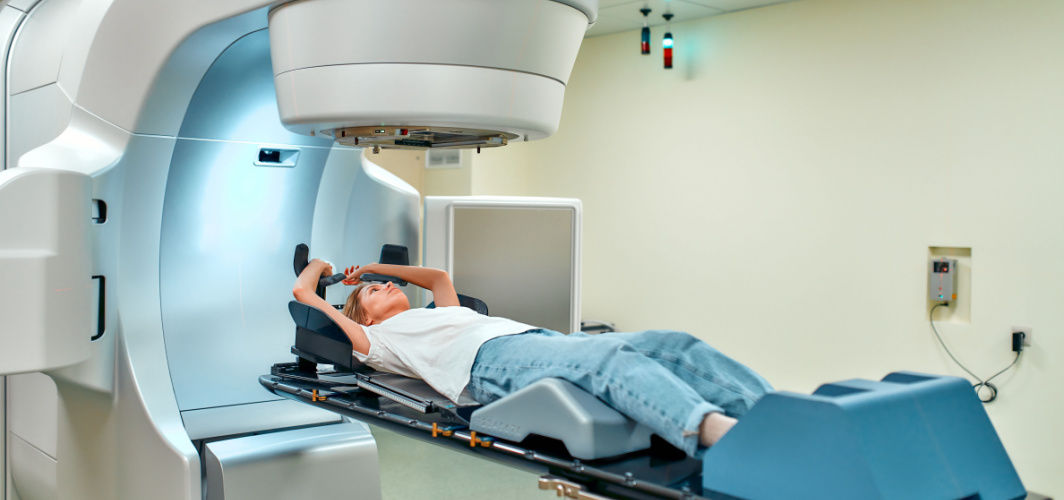General Health
What Is The Role Of Image-Guided Radiation Therapy In Treating Cancer?
4 min read
By By Dr Animesh Saha, Medical Oncology, Apollo Multispeciality Hospitals, Kolkata - 25 September 2023
Share this article
0
0 like

Image-guided radiation therapy (IGRT) is one of the most advanced innovations in cancer treatment. It uses machines called linear accelerators to deliver the radiation. It uses imaging techniques like PET, MRI, and CT to locate the targeted tumour before and during the treatments. This treatment is often used to treat liver, lung, breast, prostate, and brain cancer. In this blog, we'll guide you through how IGRT is given, what to expect during treatment sessions, potential side effects, and much more.
How is Image-guided Radiation Therapy (IGRT) Given?
Image-guided radiation therapy (IGRT) is delivered like traditional radiation therapy. Here’s an overview of the procedure:
1. Patient positioning : You will lie on the treatment table. Your doctor will ensure the tumour is in front of the radiation beam.
2. Imaging scans: Various imaging scans such as positron emission tomography (PET), magnetic resonance imaging (MRI), and computed tomography (CT) scans will be conducted to locate the tumour and surrounding tissues.
3. Target adjustment: Your radiation therapist will use these scans to adjust the radiation beam to target the tumour as precisely as possible.
4. Treatment: Once the radiation beam and patient position align correctly, your doctor will leave the treatment room to operate the machine. You will not feel any pain during your session and the session will last only a few minutes.
5. Managing reactions: Following treatment, you may experience side effects. Your doctor will address these issues and may prescribe you medications.
In some IGRT procedures, such as prostate cancer, doctors use fiducial markers made of gold, plastic, or other materials to locate the tumour. These markers are the size of a rice grain and help in precise radiation targeting. Throughout your sessions, your doctor will also monitor changes in your tumour, such as shrinkage, growth, or changes in shape.
Advantages of IGRT
The main advantage of IGRT is that it provides accurate position and information about your tumour. It helps to:
- Use higher doses of radiation to remove cancer cells
- Locate the size and position of the tumour
- Avoid harm to healthy tissues
- Keep radiation side effects minimal
How Many Sessions of IGRT Are Required?
IGRT is typically done five days a week for several weeks. However, the duration or sessions of the IGRT depends on your type of cancer, size, and location. Most treatments take multiple sessions.
Who Will Be Involved in This Procedure?
IGRT requires a skilled and experienced team to successfully and safely perform the procedure.
- During your procedure, there will be a radiation oncologist, therapeutic medical physicist, dosimetrist, and radiation therapist.
- The radiation oncologist decides which therapies will be used and the radiation dosage.
- Radiation therapists help with imaging and deliver daily treatments.
- The nurse provides details about side effects and manages treatment reactions under the radiation oncologist's supervision.
Is Any Preparation Needed for IGRT?
Things to keep in mind while going for IGRT include:
- Women should always tell their doctor if they are pregnant or breastfeeding.
- Patients with metal in their bodies should inform their doctor before an MRI.
- Patients with pacemakers should inform their doctor before an MRI.
- Your doctor will also implant markers 1-2 weeks before your CT simulation.
- They will also tattoo your skin to help align and target the radiation equipment.
- You may also be told whether to fast, drink water, or have a full bladder before the treatment.
What to Expect During the IGRT Procedure?
You may notice an odd smell during the treatment and see or hear equipment moving. Radiation treatment may cause side effects, and their severity will depend on the type of radiation, dose, and the body part under treatment. These side effects can happen during or right after the treatment. Your doctor and the nurse will help you manage them.
Side effects that may happen include:
- Hair loss
- Difficulty swallowing
- Eating and digestion issues
- Diarrhoea
- Headaches
- Nausea
- Vomiting
- Soreness and swelling
- Urinary and bladder changes
Delayed side effects that are often rare but can happen include:
- Lung infection (may cause shortness of breath, scarring, coughing)
- Brain damage (may cause memory loss, cognitive decline, stroke)
- Spinal cord damage (may cause weakness, numbness, loss of function)
- Kidney disease (may cause high blood pressure, kidney failure)
- Infertility
- Mouth dryness and sores
- Secondary cancer
When Do Doctors Recommend IGRT?
IGRT is used to target sensitive locations of the body. If your tumour is moving a lot, IGRT can get the exact location of your tumour and target the cancer cells. It can help treat various types of cancers, such as:
- Lung cancer
- Breast cancer
- Brain cancer
- Prostate cancer
- Spine cancer
- Bladder cancer
- Liver cancer
- Esophageal cancer
- Bone cancer
- Lymphoma
Takeaway
Image-guided radiation therapy is a powerful machine that uses medical imaging to locate the tumour and radiation beams to remove the cancer cells. It’s effective in high-dose delivery and does not harm healthy tissues. Patients may experience side effects but your doctor and nurse would help you handle them. Also, if you have any questions, please ask your doctor so that you can make informed decisions about your treatment and overall health.
For more information,
General Health
Consult Top Medical Oncologists
View AllLeave Comment
Recommended for you

General Health
Is Beer Good For Kidney Stones?
The utility of beer in helping kidney stone removal is a debatable topic. Since beer is a diuretic, many consider it an effective solution for passing stones. However, it's not the right approach as alcohol can lead to dehydration which increases stone formation. Here's all you need to know about beer's effect on kidney stones.

General Health
All You Need To Know About Chia Seeds
Learn more about the health benefits of Chia Seeds along with their ancient uses, nutritional value, daily consumption recommendations, and considerations for safe integration into your diet.

General Health
How To Prevent Sunstroke During A Heatwave?
Heatwaves can cause your body to dehydrate. In extreme cases, it can also lead to heat or sunstroke. Hence, you must remain indoors during a heatwave to stay cool. Drink plenty of fluids and if needed take frequent showers to stay comfortable during the heat.
Subscribe
Sign up for our free Health Library Daily Newsletter
Get doctor-approved health tips, news, and more.
Visual Stories

Science-backed Home Remedies for Burns and Blisters
Tap to continue exploring
Recommended for you

General Health
Is Beer Good For Kidney Stones?
The utility of beer in helping kidney stone removal is a debatable topic. Since beer is a diuretic, many consider it an effective solution for passing stones. However, it's not the right approach as alcohol can lead to dehydration which increases stone formation. Here's all you need to know about beer's effect on kidney stones.

General Health
All You Need To Know About Chia Seeds
Learn more about the health benefits of Chia Seeds along with their ancient uses, nutritional value, daily consumption recommendations, and considerations for safe integration into your diet.

General Health
How To Prevent Sunstroke During A Heatwave?
Heatwaves can cause your body to dehydrate. In extreme cases, it can also lead to heat or sunstroke. Hence, you must remain indoors during a heatwave to stay cool. Drink plenty of fluids and if needed take frequent showers to stay comfortable during the heat.



